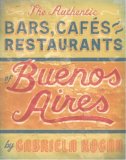
 The other day I received in the mail a review copy of The Authentic Bars, Cafes, and Restaurants of Buenos Aires
The other day I received in the mail a review copy of The Authentic Bars, Cafes, and Restaurants of Buenos Aires by Gabriela Kogan. There is a serious lack of English-language travel books about Buenos Aires other than the traditional guidebook. Kogan, a graphic designer in Buenos Aires with her own local imprint, provides a nice addition, a good supplement to, say, The Rough Guide to Buenos Aires.
by Gabriela Kogan. There is a serious lack of English-language travel books about Buenos Aires other than the traditional guidebook. Kogan, a graphic designer in Buenos Aires with her own local imprint, provides a nice addition, a good supplement to, say, The Rough Guide to Buenos Aires. The pocket-sized format of The Authentic Bars, Cafés, & Restaurants of Buenos Aires makes it an easy volume to carry around in your exploration of Buenos Aires. It certainly could be useful in pre-trip planning as a way of narrowing down some places that you want to try out. But to try all the places you basically have to live here.
The pocket-sized format of The Authentic Bars, Cafés, & Restaurants of Buenos Aires makes it an easy volume to carry around in your exploration of Buenos Aires. It certainly could be useful in pre-trip planning as a way of narrowing down some places that you want to try out. But to try all the places you basically have to live here.
I’m not a foodie and this book isn’t much on reviewing the quality of the food at these places. That type of review is best left to Dan of Casa SaltShaker or by consulting the Oleo guide to restaurants in Buenos Aires. (Also related to this topic, Dan has an extensive, bilingual English – Spanish Food & Wine Dictionary ).
).
What The Authentic Bars, Cafés, & Restaurants of Buenos Aires does provide you with is the sense of a place, a feel for the individual spots. Undoubtedly, one of the great pleasures in visiting Buenos Aires is sitting in one of the city’s classic cafés.
For my first reading of this book, I decided that there was no better place than at one of my own neighborhood cafés, so I headed over to El Hipopótamo (photo below), which oddly isn’t listed in the book though fortunately the other fine place just across the street, Bar Británico is covered.

In her introduction to the book, Kogan says
Visiting these places and writing these brief descriptions, I realized that I began to retell and relive what Buenos Aires is really like, its history in all its idiosyncrasy….writing this guide has connected me to the joy of what is genuine, of what doesn’t need language to translate. It has connected me to the essence of Buenos Aires.
There are a number of my favorite places in the book and quite a few that I didn’t know about. Some of the places are those deservedly mentioned in all the guidebooks, but then there are the other little, local places that are full of character. I often advise visitors to Buenos Aires just to walk randomly around town and drop in on any corner café. But for those people who like a little more structure, some guidance, then this book can help you uncover the charm of Buenos Aires.
Yanqui Mike also has a review of this book on his blog.
This guy playing guitar on the 39 today was not too bad.
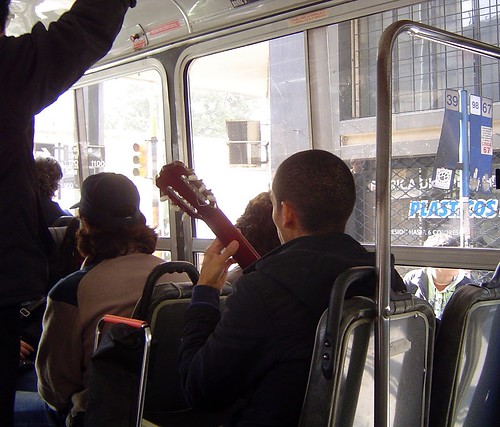
Macedonio Fernández was an enigmatic figure shadowing over the literary scene in Buenos Aires during the early 20th century.
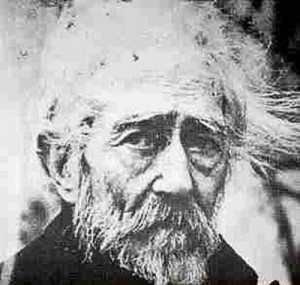
In a new essay published in The Quarterly Conversation, Marcelo Ballvé writes about the influence of Macedonio on Argentina’s most famous writer – The Man Who Invented Borges.
Both men were enamored of speculative philosophy, and arguably it was Macedonio who was responsible for making a metaphysician out of Borges. Both writers were incessant explorers of a handful of themes: the inexistence of the individual personality, the elastic nature of time, the permeability of waking life to dreams and vice-versa; one might say: the instability of reality in general. In both writers’ work the supposedly bedrock concepts by which we live are revealed to be unstable isotopes, slippery and layered, none being in essence what they appear to be and all of course eminently moldable, especially within the pages of a story, poem, or essay.
I’ve been anticipating the arrival of the cool weather that accompanies autumn and winter. We seemingly have skipped fall and landed right in the midst of a Buenos Aires winter. That’s fine with me since my preference is for cold, gray days. (How did I survive living in Miami Beach for five years?) I like bundling up in layers of wool.
Recently, a trip to my favorite thrift shop on the southside of Buenos Aires resulted in the acquisition of an alpaca scarf and a great wool sports jacket for less than 50 pesos. (Don’t bother asking. I’m never revealing the location of that store. Despite the ridiculous inflation here, bargains can still be found if you hunt around).
This climate also gives me the excuse – not that I need one – to sit in a cozy cafe, sipping a hot cup of coffee. Since I have a very limited sense of taste or smell (an attribute that was handy for drinking copious amounts of alcohol in college), I have no need to quench an advanced coffee thirst with the recent opening of Starbucks in Palermo. Even when I lived in the U.S., I’m fairly certain my visits to Starbucks never exceeded half-a-dozen trips, most of which were in the company of a friend. Just call me bland and boring or blame my damaged taste buds. Meanwhile you’re more likely to find me in a cafe with water stains on the walls while happily drinking my murky coffee.

I don’t like mixing politics with my blogs, though while prowling the Huffington Post (another thing I don’t do too often) I came across this analysis of possible vice-presidential candidates for Barack Obama.
Somewhere out there a Hillary supporter is screaming, “But he doesn’t yet have the nomination!”……true but soon…anyway, I voted for Obama.
Regardless, you really should read that analysis and the surprising recommendation for the perfect VP candidate. There’s an Argentina connection…really…but you have to read to the end of the article.
I don’t have much time for blogging lately, but this can’t go unmentioned….another sad episode for the City that Fades Away series.
Before

and a different angle…these photos were taken on a hot summer day, late January 2007…inthe photo below, also note the small house next to the one on the corner.

Now

Two buildings and an impressive mural…all illegally demolished. One of the buildings was the home of Pedro Benoit, architect and urban planner.
This deserves a much more extensive post, more than I have time for at the moment, but for those who read Spanish you can find more here and here and here and here and here and here and here and here.
This afternoon at 5pm there will be an event protesting the demolition.
Guess I’m still getting adjusted to the WordPress 2.5 admin interface (only fellow WordPress bloggers will understand)…I just accidentally deleted the last 25 comments from this blog. Damn. Sorry about that to those who left comments.
I hate how the new admin dashboard interface displays the comments awaiting moderation in the same list as the approved comments. I’ve been too tempted to click on the select all button (like I do when I only go to the awaiting moderation screen).
Anyway back to Buenos Aires posting soon….and even more frequent backups. I also should remember to be more awake when I moderate comments.
Opposite me in Britanico a man sits, tapping his fingers against the table while assorted persons wander in and out of the café selling pens, socks, jewelry, and religious pendants.

Later, a young African man with his dark sales case containing necklaces, rings, and watches enters through the corner doorway and walks directly towards the elderly woman sitting to my left. She has too much rouge on her cheeks. The African leans over and greets her with a kiss.
A regular customer of his, I assume, but today, after reviewing the merchandise in the case lined with red velvet, she buys nothing.
The African approaches me with a smile.
One of my librarian friends back in the U.S. sent me a link to a project by the University of Chicago library: Late 19th- and Early 20th-Century Latin American Cities. Included are digital copies of 2 maps of Buenos Aires held by the University of Chicago Library’s Map Collection.
Like all good online maps these days, these feature that nice zoom-and-pan tool.
Buenos Aires, 1912
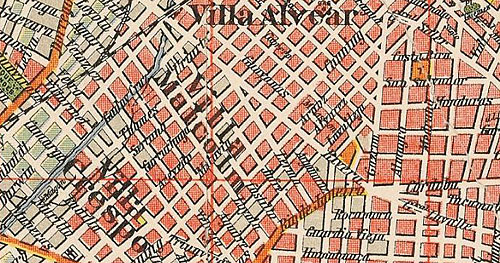
This map shows two barrios, Villa Alvear and Villa Malcolm, that have since been re-named as parts of Palermo. Personally, I like the older names.
Since tango is not a part of my Buenos Aires experience (and I don’t really wander around this part of the city too much), I didn’t realize that there is a tango joint called Villa Malcom. And here’s some video of tango dancing at Villa Malcom.
Map of Buenos Aires, 1916
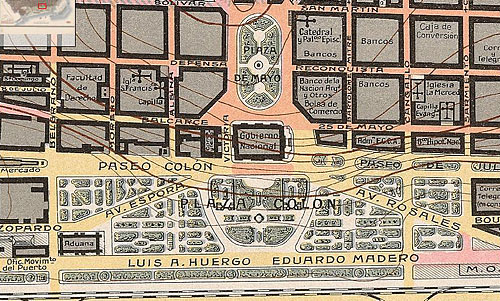
Colorful isn’t it? Plaza Colón looked very nice back in 1916.
The map is quite extensive and covers the entire city, not just the downtown. Note the topographic contour lines showing the elevation.
I find myself at Bar Britanico a lot lately and blogging about its occasional celebrity clientele or El Hipopotamo across the street. But I’ve realized from Google that many people still find my June 2006 posting about the closing of Bar Britanico, which I forgot to update to reflect the re-opening of Britanico….oops.
…A late afternoon photo taken from the window of Bar Britanico, looking out on the intersection of Brasil and Defensa streets.

« Previous Page — Next Page »

The other day I received in the mail a review copy of The Authentic Bars, Cafes, and Restaurants of Buenos Aires
by Gabriela Kogan. There is a serious lack of English-language travel books about Buenos Aires other than the traditional guidebook. Kogan, a graphic designer in Buenos Aires with her own local imprint, provides a nice addition, a good supplement to, say, The Rough Guide to Buenos Aires.
The pocket-sized format of The Authentic Bars, Cafés, & Restaurants of Buenos Aires makes it an easy volume to carry around in your exploration of Buenos Aires. It certainly could be useful in pre-trip planning as a way of narrowing down some places that you want to try out. But to try all the places you basically have to live here.
).



